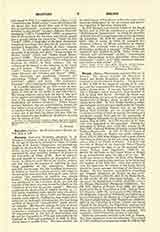

Bergen (BERGA, BERGENSIS), Ancient See of, in Norway. The diocese included the Provinces of Nordre and Sondre Bergenhus, and the district of Sondmor in the Province of Romsdal. The discovery at Selo in 996 of the supposed remains of St. Sunniva and her companions led King Olaf Trygveson to build a church there. It was not, however, till 1068 that a bishopric and a monastery were founded at Selo by King Olaf Kyrre. Bernard the Saxon was the first bishop, but later on he removed to the newly founded city of Bergen, where he died as its first bishop about 1090. In 1152 Bergen became a suffragan bishopric of the new metropolitan See of Trondhjem, and a cathedral chapter was set up there. Bishop Paul (1156-94) saw the completion of the Cathedral of Christ Church in time for the holding of a provincial council there and for the coronation of King Magnus Erlingson, the first coronation of a Norwegian king, in 1164. In 1170 the relics of St. Sunniva were translated to the cathedral. During the episcopate of Bishop Arne (1226-56), namely on July 29, 1247, Cardinal Wilhelm of Sabina crowned King Haakon Haakonsson. In 1271 the Royal Chapel of the Holy Apostles at Bergen was made collegiate. From 1275 to 1302 King Magnus built a great church (the finest in Norway), as his new royal chapel, to receive a relic of the Crown of Thorns. The dean took the title of Master of the (fourteen) Royal Chapels and was granted the right to use the episcopal ornaments. Bishop Arne Sigurdsson (1305-14) regarded the privileges of the Chapel Royal at Bergen as an encroachment upon the rights of his see. He could not, however, deprive the dean, Finn Haldorsson, of his semi-independent position, as the latter had the support of the Holy See. Arne also asserted in vain his claim that the bishops of the Faeriie Islands should be chosen amongst the clergy of the Diocese of Bergen. He was, however, successful in compelling the German merchants at Bergen to pay tithe. Bishop Thorstein (1342-49) died of the Black Death, as did nearly all the Norwegian bishops. To his successor, the Englishman Gisbrith (1349-69), we owe the Bergen Manuscript (Bjorgynjar kalfskinn). Aslak Bolt, Bishop of Bergen from 1408, was translated to the See of Trondhjem in 1430. Bishop Thorleif Olafsson (1430-50), having joined Olaf Nilsson at the Brigittine Convent of Munkalif, was killed there by the Germans of the Hansa on September 1, 1455. The last Catholic bishop, Olaf Thorkelsson (1523-35) allowed the Cathedral of Christ Church, the Royal Chapel of the Apostles, the Dominican convent, and other ecclesiastical buildings at Bergen to be destroyed, when the fortress of Bergenhus was enlarged. His successor, Geble Pedersson, became a Lutheran.
Eighteen provincial councils were held at Bergen. The most important were the following: The council of 1164 confirmed arrangements made in 1152 by the legate, Cardinal Nicholas Breakspear, with regard to the Norwegian Church. Their object was the establishment of the hierarchy by the following means: (I) the establishment on a firm basis of the Archbishopric of Trondhjem; (2) the foundation of cathedral chapters; (3) the assertion of the right of the Church to inherit property by will; (4) the enforcement of clerical celibacy. The council of 1190 decreed the excommunication of all guilty of sacrilege, violence towards clerks, rape, or of unlawfully bearing arms in church and at public assemblies. King Sverre’s Christian Law (Christenret) was published at this council. The council held in 1273 decided that parish churches in Iceland should belong to the bishop of the diocese and not to the landowners. A number of articles were also framed with a view to a reconciliation between Church and State, but they were never accepted either by pope or king. In 1280 many rules with regard to excommunication were made but not carried into effect, as the quarrel between Church and State broke out with renewed violence. At the council of 1320 a large number of regulations were made with regard to discipline. In 1327 the canons adopted at the provincial synod dealt with the relations between Church and State. The last provincial synod at Bergen was held in 1435. It dealt with the collection of money for the maintenance of the Council of Basle, the superstitious observance of Saturday, which was forbidden, and unauthorized begging on the part of religious.
Among the religious institutions in the Diocese of Bergen before the Reformation, were the following: The cathedral with a chapter of 3 prelates and 12 canons, the Collegiate Church of the Apostles (Chapel Royal), 12 canons and a dean; priories of Dominicans (from at least 1240) and Franciscans (dating from the same period). There were also at St. Mary’s, Bergen, Cistercian nuns from 1150-1507 and Canons Regular of St. Anthony of Vienne from 1507-28. At St. John’s, Bergen, there were Canons Regular of St. Augustine from about 1180 to 1489. The Hospitals of St. Catharine (for women) and of All Saints (for men) provided for the sick. Finally, the great Abbey of St. Michael’s, Munkalif (Benedictine monks, 1108-1426; Brigittines, 1426-70 and 1479-1531; Cistercian nuns, 1470-79), lay close to Bergen. The city and its suburbs contained in all no less than 26 churches. Elsewhere there were the Cistercian Abbey of Lyse, colonized from Fountains Abbey, Yorkshire, in 1146, and the Hospital of the Holy Spirit at Halsno (about 1200-1539).
A. W. TAYLOR

